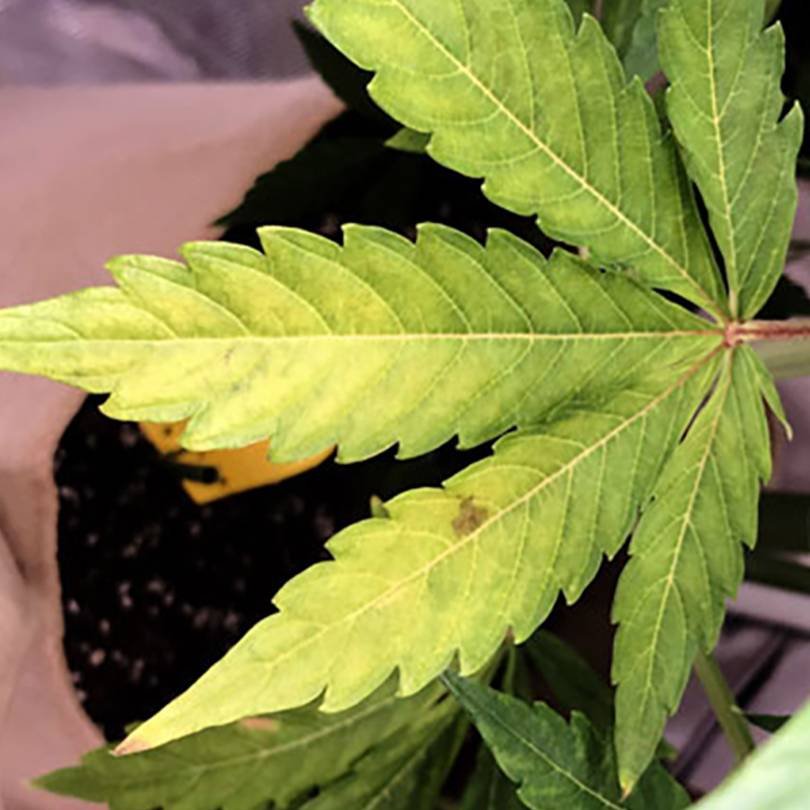Growing healthy cannabis plants means giving them exactly what they need—no more, no less. But even experienced growers sometimes face nutrient deficiencies that can hurt yield and quality. Learning how to spot these issues early and fix them can save your grow.
“I have always loved marijuana. It has been a source of joy and comfort to me for many years.”
– Hunter S. Thompson
Below are the most common cannabis nutrient deficiencies and how to correct them.
1. Nitrogen Deficiency (N)
Symptoms:
- The leaves of your plant turn yellow or pale green and it usually begins at the lower older leaves.
- Slowed growth and smaller leaves
Fix:
Your plant needs a fertilizer containing nitrogen to solve the deficiency issue. Organic growers should apply either blood meal or fish emulsion to their plants. For hydro or coco grows, try a balanced veg-phase nutrient like General Hydroponics FloraGro.
2. Phosphorus Deficiency (P)
Symptoms:
- The leaves turn a deep shade of green or show purple tints.
- Stunted growth
- The terminal portions of leaves and their edges show signs of browning.
Fix:
The products FoxFarm Tiger Bloom. Bloom acts as a phosphorus source for your plants. Soil pH should range between 6.0 and 7.0 yet hydro/coco requires a pH between 5.5 and 6.5.
3. Potassium Deficiency (K)
Symptoms:
- The leaves develop brown spots that cause edges to curl toward the center.
- Weak stems and slowed bud development
Fix:
Use a bloom booster supplement such as Advanced Nutrients Big Bud. should be added to your nutrient solution. Check your EC levels; excess calcium or sodium can lock out potassium.
4. Calcium Deficiency (Ca)
Symptoms:
- Irregular brown spots
- Twisted or dying tips
- New growth deformed
Fix:
You should use Cal-Mag supplements like Botanicare Cal-Mag Plus. Coco growers specifically require calcium supplementation since the medium has a strong affinity for this nutrient.
5. Magnesium Deficiency (Mg)
Symptoms:
- The interveinal tissue of older leaves turns yellow while the veins remain green.
- Red/purple stems
- The leaves develop a curled shape.
Fix:
The solution contains magnesium which can be delivered through Epsom salts at 1 tsp per liter of water or through Cal-Mag supplements.
6. Iron Deficiency (Fe)
Symptoms:
- New leaves develop yellow coloration but the leaf veins remain green.
- Happens at top of plant
Fix:
Your system requires flushing and you need to adjust the pH levels to their appropriate range (soil: 6.0–7.0). Use Sensi Cal-Mag Xtra as your micro-nutrient blend which includes iron as one of its components according to Advanced Nutrients Sensi Cal-Mag Xtra.
Preventing Deficiencies
To prevent most problems:
- Regularly check your soil’s pH value by using a digital pH pen for precise readings.
- Follow the established feeding schedule for your chosen growing medium whether it’s soil or coco or hydro.
- Salt accumulation in the water should be removed through flushing because it blocks nutrient absorption.
Final Tip: Keep a grow journal. Your ability to diagnose issues in upcoming grows will improve through documenting symptoms together with feeds and pH measurements.
Read More Article : How to Control Humidity in a Grow Tent Easily
